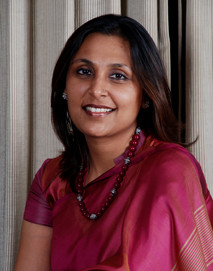
Padmini Somani is no ordinary foundation head. She leads both her family’s 12-year-old philanthropy, the Narotam Sekhsaria Foundation, named for her father, a visionary entrepreneur, and Salaam Bombay, a public foundation established in 2002 that focuses on eradicating smoking among Indian youth in the state of Maharashtra. With a staff of 80, Salaam Bombay Foundation has collaborated with the Harvard School of Public Health on measurement, and spearheaded collaborative funding and program implementation; it has received grants from the Bill & Melinda Gates Foundation and Bloomberg Family Foundation, among others.
Alison Powell & Katie Smith Milway: Could you tell us how Salaam Bombay Foundation goes about its mission to end smoking?

Padmini Somani: The Salaam Bombay Foundation (SBF) was founded to reduce the availability and use of tobacco among children across the state of Maharashtra and to build a model for ending youth smoking across India. We are attacking a wicked problem: Today 36 percent of Indians are under 18, and one in every three tobacco users in India started using before the age of 10. As a result, we are seeing cancer manifesting in people in their 20s, and many don’t come to the hospital until a very late stage.
We’ve gone about the work by empowering kids with knowledge and life skills, working with 200 schools in Mumbai, and training more than 50,000 teachers and 500,000 students in Maharashtra in understanding root causes of tobacco addiction. SBF provides role models and helps children to develop self-confidence, resist peer pressure, develop a positive self-image, grow leadership and decision making skills, and broaden their horizons through English proficiency, sports, and art. These are things that can help them toward a college education or job. We also empower children to understand the tobacco control law and train them to be advocates who can help to implement the law and work for change policy.
When we started, we realized that there was no organized assistance for smoking cessation in India, and we learned there was no established or evidence-based cessation protocol for children anywhere in the world. So we reached out to the Mayo Clinic, Massachusetts General Hospital, and others to adapt methods they used to suit India’s primarily smokeless tobacco users. If we are successful, we will have one of the first tobacco cessation protocols for children.
When the Harvard School of Public Health evaluated the impact of your programs, what did you learn?
The evaluation was very positive in many ways. One of the biggest challenges for philanthropy in India is to get feedback—some sort of metrics on return on investment. The Harvard School of Public Health tested tobacco use rates at schools where we were intervening and at those where we were not. The data showed that the intervention schools had less than 50 percent tobacco use compared to non-intervention schools. And it showed that our students were not only less likely to smoke, but also more likely to prevent others from smoking.
We learned about ways to strengthen our program too. For example, we were debating whether to work with the same group for one year or two years. Often, grassroots NGOs struggle between cost and impact, and we were wondering, “Does it really make sense to work [with students] for three years?” By the time we finished the research, we realized the importance of [the longer] “dosage” and that we should keep the program in the schools for an extended number of years. Without the study, we might have taken shortcuts.
Now tell us about your family philanthropy, the Narotam Sekhsaria Foundation?
Our family foundation, based in Bombay, has a staff of 25 making grants that focus on education, health care, livelihood, governance, and arts and culture—anywhere in the country. Across all of these, we focus on capacity building.
Though the government provides free education, the village school may lack teachers, books, means of access, and good outcomes. We have a public school proficiency gap; most students who come out of that system may lack the skills necessary for employment. There are a lot of these “last mile” gaps in India where people lack access to facilities created by the government.
So we like to make grants to develop collaborative programs among NGOs and the government. In health care, we train surgeons in specific areas of oncology; India has the highest rate of head and neck cancer in the world (linked to smoking). So we started capacity-building at government hospitals. We provide fellowships to train doctors [to perform oral cancer surgeries], then send them out to different corners of the country.
Are there insights from your work that you share with other philanthropists in India or abroad?
We have found that big foundations are afraid to fund nonprofits [whose work] doesn’t translate into a performance metric. But there are many good, capable, grassroots organizations in India, doing work on the ground, which have a gap in their ability to provide measures. We want to help [these smaller organizations] build measurement capacity. Sometimes we build into the grants an extra component of financing, specifically so that the grantee will document their effort. For a fellowship project that we fund in Rajasthan, we paid for an external evaluation.
Another problem that we see: When foundations fund large interventions, sometimes the project distorts outcomes. For example, if a project is to last three years and an NGO wants to show results, it may make an extra payment to a teacher (who is already paid by the government) to push the program. This can buy results in the short term, but when the observation period ends, the project completely collapses.
You can overfund an idea or proof point. We ask, “How will this sustain itself?” and sometimes we build in a grant component to help the organization broaden its funding base. It’s very important for us not to dig a big, deep hole, and then leave.
What is the biggest challenge you are facing right now and how are you tackling it?
For both foundations, our biggest challenge is effective collaboration. Can we, as philanthropists, build a neutral platform for the best thinking and action? Too often NGOs do not think of sharing their resources or insights. Once, several organizations working with adolescents in India applied to us for funding to create resource material for their target group—the adolescents. We saw that the material they all wanted to create was pretty much the same, and that their desire to create a unique set of materials was a hindrance to networking with each other. We brought all of them to one round table, and offered to support the material development initiative if all of them were willing to share the material and ensure broader outreach.
At Salaam Bombay, we are training master trainers to execute the smoking cessation program, so we’ve built capacity that can help other NGOs.
We cannot force organizations to work in collaboration, yet no one organization can scale across the whole of India—it’s a huge country. So we are trying to build these civil society collaboratives, including funders working in collaboration … and it’s exhausting.
What approaches are other philanthropies taking to build collaboration? We’d love to hear.
Support SSIR’s coverage of cross-sector solutions to global challenges.
Help us further the reach of innovative ideas. Donate today.
Read more stories by Alison Powell & Katie Smith Milway.

